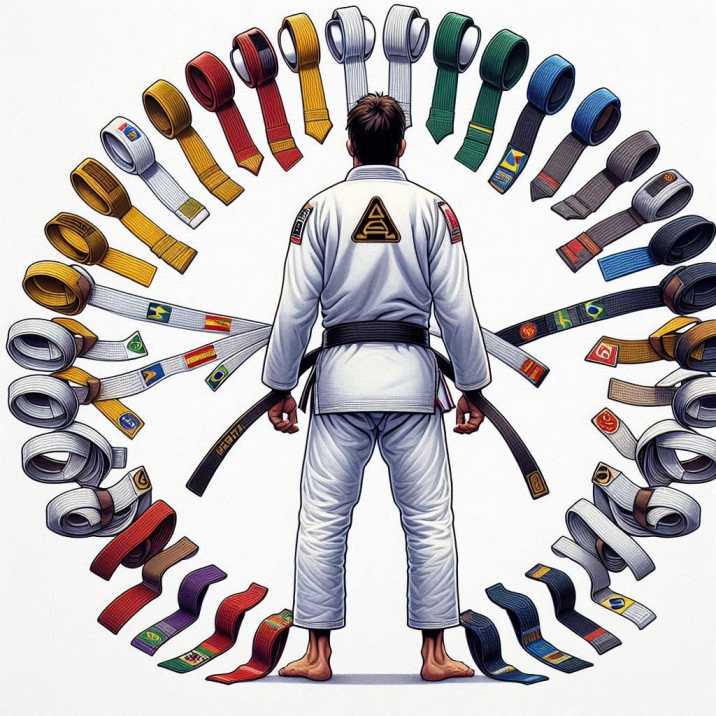Introduction
Table of Contents
Brazilian Jiu Jitsu (BJJ) is a popular martial art that focuses on grappling and ground fighting. It’s not just about self-defense; it’s also about discipline, perseverance, and personal growth. One of the most exciting aspects of BJJ is progressing through the belt system, which signifies a practitioner’s skill level and experience. But what exactly are the belts in Brazilian Jiu Jitsu, and what do they represent? In this article, we’ll explore the different belts in BJJ, explain how you can advance through them, and highlight what each belt symbolizes.

The Belt System in Brazilian Jiu Jitsu
Brazilian Jiu Jitsu (BJJ) is structured around a system of colored belts that signify a practitioner’s progress, skill, and understanding of the art. The journey through the BJJ belt system is long and challenging, requiring dedication, discipline, and consistent effort. Here’s an in-depth look at each belt and what it represents.
White Belt – The Beginning
The white belt is the first step in your BJJ journey. It represents a fresh start, much like a blank canvas waiting to be filled with knowledge and experience. At this stage, practitioners are just beginning to learn the basic techniques and principles of Brazilian Jiu Jitsu.
- Symbolism: The white belt symbolizes a beginner’s openness to learning and growth.
- Training Focus: As a white belt, you’ll focus on mastering the fundamental techniques such as escapes, positional control, and basic submissions. You’ll also learn key defensive tactics to protect yourself in various positions.
- Typical Duration: Most practitioners remain at the white belt level for 1-2 years, depending on how frequently they train and their ability to grasp the fundamentals.
The white belt phase is crucial because it sets the foundation for everything that follows in BJJ. Building a strong foundation at this stage will make it easier to advance through the ranks.
Blue Belt – The First Milestone
Earning the blue belt is a significant achievement in Brazilian Jiu Jitsu. By this point, you’ve built a solid understanding of the basics and can start to apply them in live situations, such as sparring or rolling with partners.
- Symbolism: The blue belt represents the first major step toward proficiency in BJJ. You’ve moved beyond the beginner stage and are starting to develop your unique style.
- Training Focus: At this level, the focus shifts to defense and positional control. Blue belts learn to maintain dominant positions and defend against attacks, while also honing their submission techniques. The emphasis is on refining the basics and applying them in more dynamic situations.
- Typical Duration: Achieving a blue belt usually takes 2-3 years of consistent training.
The blue belt phase is often where practitioners face the most challenges, as they refine their skills and start to understand the complexity of BJJ.
Purple Belt – The Intermediate Level
The purple belt is a significant milestone that marks the transition from intermediate to advanced BJJ. Purple belts have spent years honing their skills and have developed a deeper understanding of the art.
- Symbolism: The purple belt signifies that the practitioner has a high level of competence in BJJ and can now start to explore their creativity within the art. It’s a point where you start to refine your own personal style and strategy.
- Training Focus: Purple belts focus on advanced techniques, combining multiple moves, and executing complex strategies during sparring. They often take on mentoring roles, helping less experienced students improve their skills.
- Typical Duration: The purple belt stage can last anywhere from 3-5 years, as practitioners deepen their knowledge and fine-tune their techniques.
The purple belt phase is also a time for practitioners to explore their personal approach to BJJ, often experimenting with different strategies and techniques to find what works best for them.
Brown Belt – The Expert
The brown belt is the final step before achieving a black belt. At this stage, practitioners are considered experts in Brazilian Jiu Jitsu, with a deep understanding of the techniques and strategies that make up the art.
- Symbolism: The brown belt signifies mastery of the techniques learned at earlier levels and a readiness to teach and mentor others. It also indicates that the practitioner is close to reaching the pinnacle of BJJ.
- Training Focus: The focus for brown belts is on polishing their techniques, refining their approach to the art, and preparing for the responsibilities of being a black belt. Many brown belts begin teaching or assisting in classes, sharing their knowledge with others.
- Typical Duration: The brown belt phase typically lasts 1-2 years, depending on the individual’s progress and dedication.
During the brown belt stage, practitioners often focus on perfecting their techniques and strategies in preparation for earning the black belt.
Black Belt – The Mastery
The black belt is the highest rank in Brazilian Jiu Jitsu and represents true mastery of the art. However, achieving a black belt doesn’t mean the journey is over – in fact, it’s just the beginning of a new chapter.
- Symbolism: The black belt symbolizes mastery of the techniques and philosophies of Brazilian Jiu Jitsu. It also represents a commitment to continue learning, growing, and contributing to the BJJ community.
- Training Focus: Black belts focus on teaching and sharing their knowledge with others, while also continuing to refine their skills. They often take on leadership roles within their schools and help guide the next generation of practitioners.
- Typical Duration: Earning a black belt is a lifelong achievement, and black belts continue to train, learn, and evolve throughout their lives.
The black belt is not just a recognition of skill – it’s a symbol of dedication, perseverance, and a deep understanding of the art. Black belts are expected to be ambassadors of Brazilian Jiu Jitsu, helping to spread the art and its values to others.
Stripes – Progress Within the Belts
In addition to the belts, Brazilian Jiu Jitsu uses stripes to indicate progress within each belt. Stripes are awarded based on skill improvement, attendance, and overall contribution to the BJJ community. Each belt typically has four stripes before moving on to the next rank.
The Importance of Belt Promotions in BJJ
Belt promotions in BJJ are not given out lightly. They are based on a combination of skill, time spent training, and contribution to the community. This system ensures that each promotion is meaningful and represents a significant milestone in the practitioner’s journey.
Why Belt Colors Matter
The belt colors in Brazilian Jiu Jitsu are more than just symbols of rank. They represent the journey, the challenges, and the growth a practitioner experiences. Each belt color has a deep significance that reflects the progression from a beginner to a master.
- White: Purity and readiness to learn
- Blue: The sky, symbolizing growth and expansion of knowledge
- Purple: The blend of blue and red, representing creativity and passion
- Brown: Earth, indicating grounding and mastery
- Black: The culmination of all colors, symbolizing mastery and depth of knowledge
Table of Belts in Brazilian Jiu Jitsu
| Belt | Color | Duration | Focus Areas |
|---|---|---|---|
| White | White | 1-2 years | Basic techniques, defense |
| Blue | Blue | 2-3 years | Defense, positional control |
| Purple | Purple | 3-5 years | Advanced techniques, combinations |
| Brown | Brown | 1-2 years | Polishing techniques, teaching |
| Black | Black | Continuous | Mastery, teaching, evolving the art |
Conclusion
Understanding the belt system in Brazilian Jiu Jitsu is key to appreciating the art’s structure and philosophy. Each belt represents not just skill progression, but also personal growth, discipline, and a deeper understanding of BJJ. Whether you’re just starting out as a white belt or aiming for the black belt, remember that BJJ is a journey that requires dedication, patience, and a willingness to learn.

FAQs About Brazilian Jiu Jitsu Belts
- How long does it take to get a black belt in Brazilian Jiu Jitsu?
- It typically takes 10-15 years of consistent training to earn a black belt in BJJ.
- What is the hardest belt to earn in BJJ?
- The blue belt is often considered the hardest because many students quit during this phase.
- Can you skip belts in Brazilian Jiu Jitsu?
- No, in BJJ, you must progress through each belt in order.
- How many stripes are needed to move to the next belt?
- Generally, four stripes are required to advance to the next belt level.
- What is the youngest age to start BJJ and earn belts?
- Kids can start BJJ as young as 4-5 years old and progress through a modified belt system.


